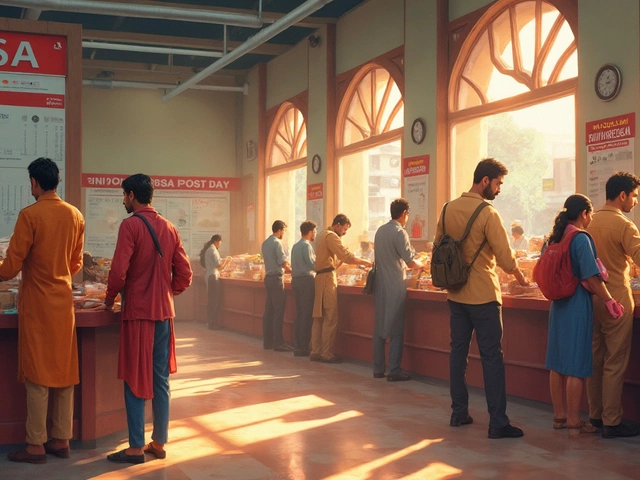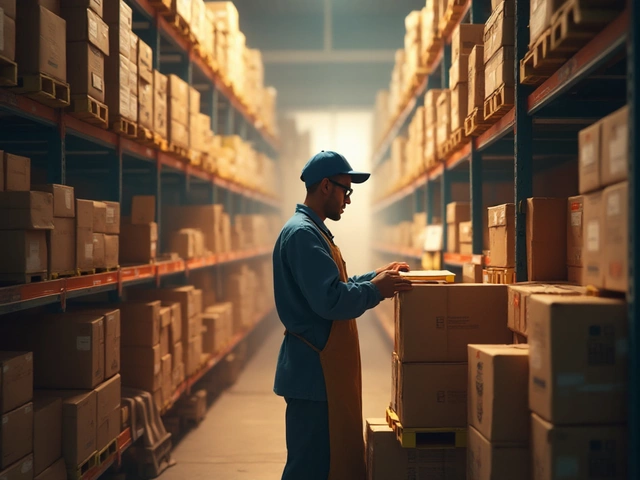In an era where time is of the essence, courier services have emerged as silent heroes, tirelessly working behind the scenes to ensure our parcels journey from Point A to B with unwavering precision. Whether you're eagerly awaiting a book you've ordered or shipping a critical document across the globe, couriers play a pivotal role.
Delving into the world of courier services reveals a fascinating blend of technology, logistics, and human expertise. From small packages delivered to your doorstep overnight to large freight transported internationally, these services must navigate an array of challenges to meet customer expectations for speed and safety. Understanding how courier companies operate not only satisfies curiosity but also empowers you to make informed decisions when selecting a service for your specific needs.
- Evolution of Courier Services: A Brief History
- The Mechanics of Modern Courier Operations
- Unique Challenges and Solutions in Courier Logistics
- Choosing the Right Courier Service for Your Needs
Evolution of Courier Services: A Brief History
From ancient beginnings to the digital age, the journey of courier services has been nothing short of remarkable. Historically, couriers have been vital in ensuring communication and transportation of goods across vast distances. The inception of courier services can be traced back to ancient civilizations, where messengers played crucial roles.
Ancient and Medieval Couriers
In ancient Egypt, messengers on foot or horseback delivered papyrus scrolls across the Kingdom. Similarly, the Persian Empire utilized an advanced system of mounted couriers called the Angarium spanning thousands of miles, with relay stations set up along the royal roads.
Fast-forward to the Middle Ages, and we see courier services becoming more organized. In the 16th century, Austrian couriers of the Thurn and Taxis family became famous for creating one of the earliest postal systems across Europe. These couriers ensured prompt delivery using horses and relay stations—a precursor to modern express package delivery systems.
The Industrial Revolution and Beyond
The Industrial Revolution marks a significant leap in the evolution of courier services. With the advent of steam engines and railroads, parcels and letters could be carried more quickly and efficiently over longer distances. This period saw the birth of notable courier companies, many of which have evolved into today's logistics giants.
| Year | Development |
|---|---|
| 1839 | Carrier pigeons used during the Great Barrier Reef incident to deliver messages to shore. |
| 1907 | The founding of a notable package delivery company in Seattle, USA, which later became UPS. |
The Digital Era and Beyond
The introduction of the internet and digital technology revolutionized courier services once more. Today, with GPS tracking, robotic sorting, and drones on the horizon, the industry has embraced cutting-edge technology to meet growing demands for swift and reliable service. Customers can not only send packages but also track their journey in real-time, thanks to integrated systems.
In an era driven by rapid technological advancement, courier services have adapted continually, focusing on speed, reliability, and efficiency. From ancient relay stations to pressing a button for express shipping, couriers continue to be indispensable in our interconnected world, evolving to meet the ever-changing needs of individuals and businesses alike.
The Mechanics of Modern Courier Operations
The world of courier services operates much like a well-oiled machine, synchronized and streamlined to meet the demands of today’s fast-paced delivery landscape. At the heart of these operations lies a sophisticated network of logistics strategies, innovative technology, and human expertise that work in unison to transport packages swiftly and safely.
Logistics and Routing
One of the fundamental aspects of any package delivery service is the optimization of routes. Couriers employ advanced algorithms and GPS technology to determine the most efficient paths for every delivery. This ensures not only timely arrivals but also reduces fuel consumption and operational costs. Couriers often use hub-and-spoke models, where goods are transported to centralized hubs for sorting before reaching their final destinations. This method, combined with real-time tracking, enables companies to manage thousands of parcels at any given time.
Technology-Driven Efficiency
Modern courier services are heavily reliant on technology. From state-of-the-art warehouse sorting systems to AI-driven dispatching, technology plays a crucial role. Barcodes and RFID tags help in tracking packages through every stage, while customer apps provide real-time updates. Furthermore, some companies are experimenting with drones and autonomous vehicles for last-mile delivery, aiming to revolutionize the express shipping segment.
Managing Challenges
The logistics sector faces numerous challenges, from fluctuating fuel prices to unforeseen weather conditions. To mitigate these, courier companies invest in predictive analytics and risk management strategies. By analyzing historical data, couriers can anticipate potential delays and reroute packages accordingly, maintaining the flow of shipments even during disruptions.
Sample Delivery Timeline
| Stage | Process | Technology Used |
|---|---|---|
| Pickup | Collect package from sender | GPS and mobile app |
| Sorting | Arrange packages by destination | Automated sorting systems |
| Transport | Move to distribution center | GPS routing |
| Delivery | Final handover to recipient | Driver apps and e-signature |
Such reliance on cutting-edge technology not only enhances efficiency but also significantly boosts customer satisfaction. Being able to track your parcel in real-time, or receive a notification a few minutes before it arrives, exemplifies the blend of convenience and reliability modern couriers strive for.
By understanding these mechanisms, customers can appreciate the extensive efforts and considerations that go into each logistics operation. It's not merely about moving items from one place to another; it's about crafting a seamless experience that resonates with the expectations of the modern consumer.

Unique Challenges and Solutions in Courier Logistics
Navigating the courier landscape is akin to maneuvering through a labyrinth, where each turn presents distinct hurdles. From traffic jams in bustling metropolises to handling delicate parcels, the challenges are as diverse as the packages themselves. Yet, these challenges only bolster the innovation driving the courier industry, compelling it to devise smart, efficient solutions.
1. Urban Congestion and Traffic Delays
In major cities, traffic congestion is a daily bane that courier services must contend with. Navigating narrow streets and dodging endless red lights can significantly delay package delivery. To counteract this, many firms now leverage electric bikes and pedestrian couriers, which are both eco-friendly and traffic-proof. Moreover, routing software powered by real-time traffic data helps drivers opt for the quickest paths, ensuring timely deliveries regardless of the street snares.
2. Perishable and Fragile Goods
Transporting perishable items or delicate electronics demands extreme caution. A single misstep can render items unusable. Couriers address this by employing temperature-controlled vehicles for perishables and using specialized cushioning for fragile goods. Moreover, training couriers extensively on handling such packages minimizes risks and enhances customer trust.
3. Last-Mile Delivery Efficiency
The 'last-mile'—the final step of the delivery journey—remains notoriously complex and resource-intensive. With consumer expectations skyrocketing, couriers innovate constantly. Implementing drones for rural areas and locker systems for urban settings are a few of the experimental solutions aimed at enhancing last-mile efficiency.
Strategies for Optimizing Last-Mile Delivery
- Using AI-driven algorithms to predict and enhance delivery routes.
- Implementing smart lockers at strategic locations to reduce home delivery attempts.
- Employing crowd-sourced delivery models, utilizing local drivers to reduce time and costs.
A fascinating study published by the Global Logistics Research Forum highlights that optimizations in the last-mile delivery can decrease costs by up to 28%, significantly boosting profitability and reducing delivery times.
4. Fluctuating Customer Demands
As e-commerce booms, consumers demand faster, more flexible courier services. This necessitates a responsive, scalable logistics framework. Many courier companies have turned to machine learning to predict demand spikes, adjusting their workforce and fleet availability dynamically. This ensures they remain agile enough to handle seasonal shopping surges, like Black Friday or Christmas, seamlessly.
In conclusion, the courier industry is a dynamic field, continuously overcoming various challenges with resilience and creativity. By embracing technology and innovative practices, courier companies not only enhance their logistics but also ensure that we stay connected through swift and reliable deliveries.
Choosing the Right Courier Service for Your Needs
In today's fast-paced world, selecting the right courier service can feel like choosing a needle in a haystack. With a plethora of options, how do you determine which company will best handle your precious deliveries? Understanding your specific needs and evaluating courier services against critical criteria will guide you to a well-informed choice.
Define Your Delivery Requirements
Firstly, identify what kind of items you plan to send. Are they documents, packages, or heavy freight? Does the delivery require special handling or insurance? Knowing your needs will help narrow down the options significantly.
Speed and Reliability
One of the essential factors for any courier service is their ability to deliver packages swiftly and reliably. If you frequently require overnight or same-day deliveries, ensure your chosen service excels in these areas. Many businesses rely on same-day delivery for critical documents, so past performance on speed should be scrutinized.
Coverage Area
Check the service's delivery range. For international shipments, choosing a courier with a robust network of partners across the globe ensures seamless handling. Locally, consider companies with comprehensive domestic routes for reliability in national deliveries.
Cost-Effectiveness
While speed is critical, it shouldn't break the bank. Compare prices among several courier services while keeping an eye on additional fees that might incur for special handling, insurance, or weight excess. Consider if they offer discounts for bulk dispatches or loyalty programs beneficial for frequent senders.
Customer Support
Strong customer support can be a lifesaver when things go awry. Evaluate the company's reputation for handling inquiries and resolving issues promptly. A dedicated support team is often an indicator of the company's commitment to customer satisfaction.
Technical Capabilities
In an age of smartphones, real-time tracking is a must-have feature. Look for services providing updates at every stage of the delivery process. This technology not only offers peace of mind but bolsters the service’s transparency.
To aid your decision-making process, consider this comparison of key factors:
| Feature | Services A | Services B |
|---|---|---|
| Delivery Speed | Overnight | 2-Day |
| Coverage | Global | Regional |
| Cost | Premium | Budget |
Remember, the right courier service acts not just as a delivery medium but as a bridge between sender and recipient, affecting client satisfaction and perception of service. Your choice should reflect not only on current needs but also on prospective scalability as those needs grow or evolve.





